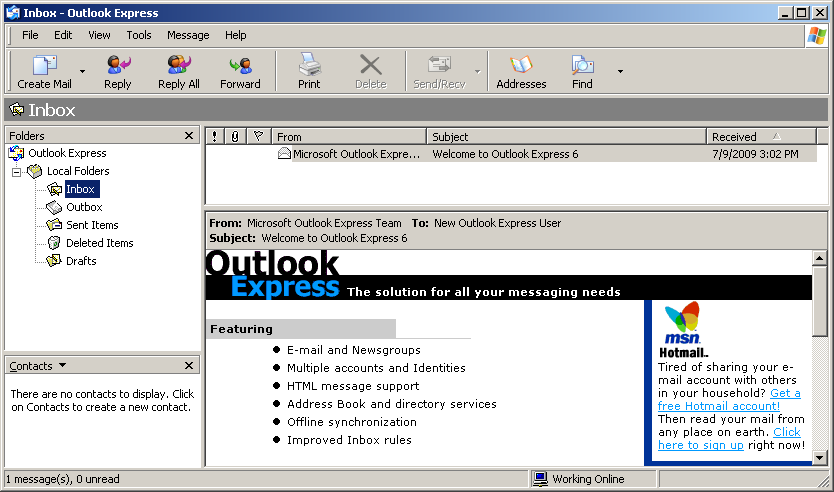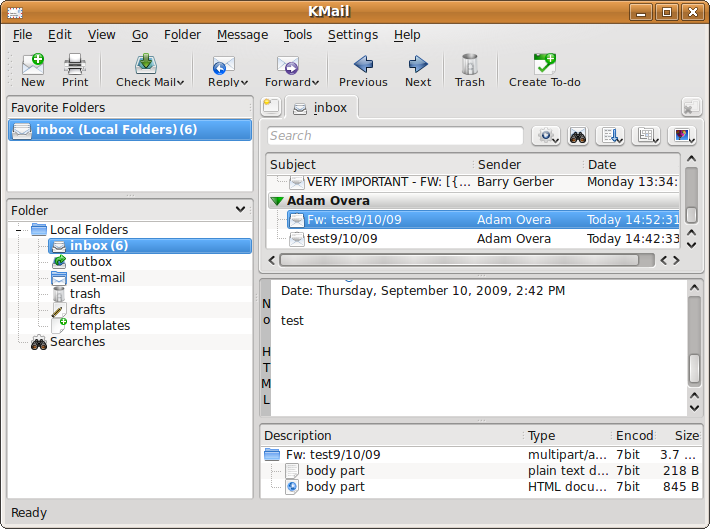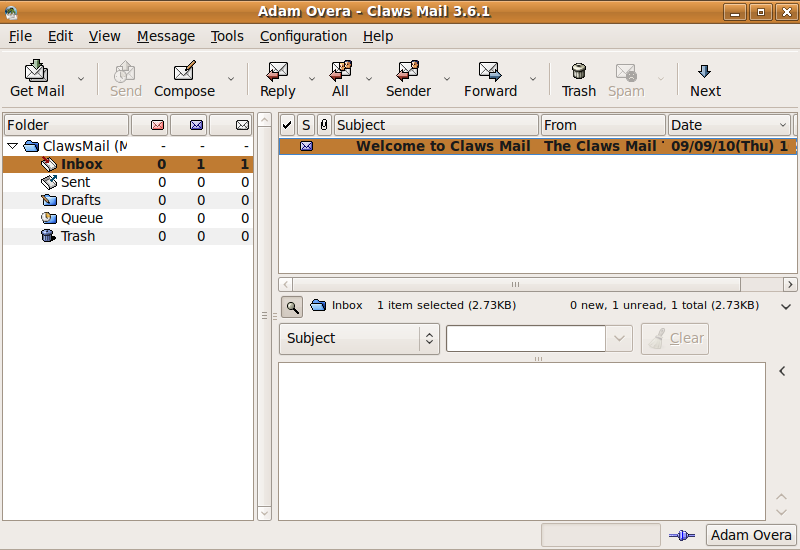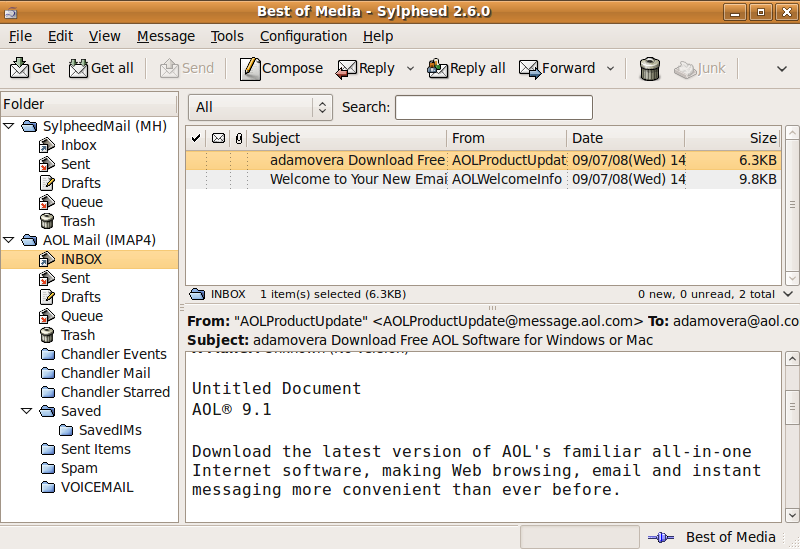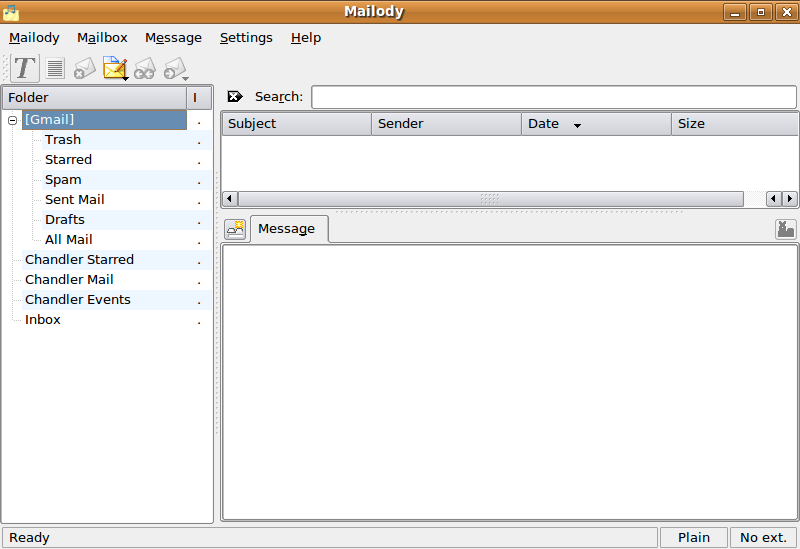Tom's Definitive Linux Software Roundup: Communications Apps
Email Clients
First off, Web mail services like Hotmail, Gmail, and Yahoo aren't covered here. For the most part, Web mail is OS-neutral; it's your Web browser that they depend on. If your email address is provided to you by your ISP or the company that you work for, you will most likely need an email client. This section is devoted to applications that allow you to send, receive, and store emails locally on your PC.
Even if you prefer having a Web-based mail account, many of these apps allow access to them as well. The email clients were stacked up against Microsoft Outlook Express, which was included in Windows 98/98 SE/ME/2000/XP and rebranded to Windows Mail in Vista. The full retail version of Outlook is technically categorized as the much more robust “personal information management” software. For testing, I used the same email accounts used to test the PIMs: @bestofmedia.com (SSL), Gmail (POP), Windows Live (POP), and AOL (IMAP).
KMail (v. 1.11.2)
As you might have guessed KMail is the email client for KDE. Kmail is definitely closer to Outlook Express/Windows Mail than Outlook; it is just the email portion of Kontact, the KDE personal information management suite.
If you're looking to replace Outlook, seek out Kontact. If all you need is an email client, KMail will do the job just fine. Setting up my @bestofmedia, Gmail, Windows Live Mail, and AOL accounts was accomplished using the Account Wizard from Tools in the menu bar. Surprisingly, KMail's wizard had the smallest number of options, yet was able to set up all four accounts without a hitch, thus making KMail the most user-friendly email client to configure.
You can mark emails as important or tag them as friend, business, or later, which applies a color coding to their titles. There is an option to create To-Do/Reminders, but that feature opens KOrganizer, a separate application. Like with most KDE apps, KMail is going to be more attractive if you use KDE. One cool feature of KMail is that your searches are automatically saved under the Searches heading below your account folders. The initial startup is pretty slow, and the font/object sizes are noticeably small under GNOME.
Mozilla Thunderbird (v. 2.0.0.22)
Get Tom's Hardware's best news and in-depth reviews, straight to your inbox.
Thunderbird is the email client from Mozilla, makers of the popular Firefox Web browser. Though Thunderbird doesn't have the huge chunk of market share that Firefox does, largely due to the soaring popularity of Web mail, it is still the most popular option available for Linux.
Thunderbird had no trouble with my @bestofmedia account and setting up my Gmail account was a breeze using the account setup wizard. Even though there is no easy template for Window Live or AOL accounts, setting them up was relatively painless as well. Thunderbird is the only client that, by default, makes a separate set of folders (inbox, outbox, etc) for each account; most other clients add accounts to a master set of folders.
In order to avoid continually searching for the same emails repeatedly, Thunderbird allows you to save searches in a search folder under the applicable account. My major problem with Thunderbird is that it will continually ask for confirmation to ignore a security certificate every time it checks for new mail, by default, every ten minutes. Most of the other clients in this roundup give you the option to always accept or ignore.
Claws Mail (v. 3.6.1)
Though it might not be the most user-friendly email client, Claws Mail makes up for it in customization. This client is not lacking in configuration options. For sorting, you can apply tags or color code emails, along with the usual “mark as” options. The interface layout can be changed to a few different variations on pane placement.
There is no easy account setup wizard, but the fact that you can specify any setting when adding a new account or editing an existing one lets Claws work with almost any address. All four test accounts worked with little or no tweaks needed. Claws does not come with a built-in spam filter. Instead, there are a number of them available as optional plug-ins. Claws does include a powerful search tool that will collect all addresses or URLs in a single email or an entire folder. If you want an email client that has only core functionality out of the box, but is extensible to basically any need, Claws is certainly a good option.
Sylpheed (v. 2.6.0)
I was able to set up all four test accounts in Sylpheed without problems. This app does not come with a functioning built-in spam filter. Apart from the abilitiy to add/remove buttons to the 'navigation bar', assigning panes to separate windows is basically the most customization you'll get from the interface.
Sylpheed has a system tray icon from which you can compose new mail, check mail, send queued massages, or exit. For some reason, the app doesn't close or minimize to the tray, nor does the icon alert you to any new mail. As with many apps, this makes me wonder why there is even a system tray icon to begin with.
To store emails, Sylpheed sets up a folder called “Mail” in your Home directory. If you are installing several email clients, be aware that this could potentially cause conflicts if any of the other clients take a similar approach. Sylpheed is good for basic email, with few extra bells and whistles. It is, however, pretty fast when compared to the other email clients, both in terms of initial load time and general responsiveness.
Mailody (v. 1.5.0-alfa1)
Mailody is not a full email client like Thunderbird or KMail. It is only capable of utilizing IMAP accounts, leaving anyone with POP accounts out in the cold. I was able to get my Gmail account set up using the alternate IMAP settings, and the AOL account was no problem. Unfortunately, they both wouldn't work at the same time because Mailody is a one account client.
Mailody is fast and light, but being a KDE app, I'm not sure what the benefit of that really is here. KDE typically requires a beefier system than other GUIs, and you'll get a performance decrease in any other environment. On top of that, there is no official RPM package. With the DEB/KDE combination being so rare, I have to wonder who the target audience for this app is. If you are in the niche who use only one IMAP account, this is a great little app, otherwise it's going to be of no use.
Current page: Email Clients
Prev Page Personal Information Managers Next Page Multi-Protocol Instant Messengers-
mitch074 I'd like to add something to the article...Reply
- Skype for Linux is currently in version 2.1 (beta) which differs from 2.0 (final) only in the fact that it is now able to deal with ALSA, OSS and PulseAudio transparently - and it doesn't wreck webcam outputs as much.
- Skype for Linux has supported video ever since version 2.0 (beta); it does work quite well if your webcam sends uncompressed video to the system (if your webcam streams MJPEG and you have a 2.6.28+ kernel, you will need some hacker-fu; details on demand)
- a quite well known single protocol IM is aMSN, which is also multiplatform; its other main advantage is that it supports voice and video chats. However, it's not always very stable and requires manual setting up of a TCP port for video and voice to work properly. -
How about benchmarking the applications. Which ones use more ram vs. functionality? How about responsiveness and stability? Those are questions I would like to see laid out because much of the Linux user base have older hardware and don't like things eating away their CPUs and ram.Reply
-
oralward You should really cover something with kde desktop as only because of protest by gnome users is it still the default desktop in any of the three versions you are covering. Its also easier for someone coming from windows. There is a version of ubuntu called Kubuntu that uses kde. This is the other main desktop.Reply -
Great article.Reply
As far as KDE vs. Gnome, I see no problem with the current format, maybe just do a Ubuntu(Gnome) vs. Kubuntu(KDE) vs. Xubuntu(Xfce) vs. MoonOS/OpenGEU/JAD(Enlightenment) roundup, to show off the different desktops(and the few apps that only work on a particular desktop). Any look good with the right theme and some Compiz/Beryl, but KDE and Enlightenment have an edge right out of the box. -
rrockman It's... "Surprising" that you didn't analyze Mercury, one of the most advanced multi-account IM apps.Reply -
haplo602 ah gui only options ... well have a look at CenterIM when you have time. It's a great little IM tool that runs in the terminal. This way I can get to my client everywhere with just a simple ssh client :-)Reply -
"The one major protocol that Empathy supports and Pidgin doesn't is the increaasingly-popular Jabber."Reply
This is just plain wrong. Pidgin has supported Jabber for a long time. It's called XMPP in the later versions which is the name of the protocol used by jabber clients -
rdawise Again, I praise Mr. Overa's coverage of Linux. I am looking forward to the Games section of Linux since I don't have much experience with native games.Reply -
jppayne2 "My major problem with Thunderbird is that it will continually ask for confirmation to ignore a security certificate every time it checks for new mail, by default, every ten minutes. Most of the other clients in this roundup give you the option to always accept or ignore."Reply
Actually, Thunderbird allows you to permanently accept the certificate, which will do what you want. Just pay attention when the confirmation dialog comes up, and select "Accept this certificate permanently". It's the first option (the default is the second option, which is to accept the certificate for the current session).
